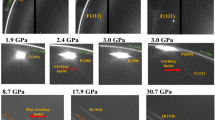Abstract
A rhombic four-atom unit cell corresponding to a close-packed atomic layer is considered, The interatomic forces in the cell are defined by the Morse and Lennard-Jones potentials for large strains. The stability region of the cell is constructed as a function of two parameters that model tension-compression along the major diagonal of the cell and shear. For each point in the stability region, equilibrium states of the cell are determined numerically; at least one of these states is stable. It is shown that for the close-packed atomic layer under combined compression-shear loading, Poisson’s ratio needs to be taken into account.
Similar content being viewed by others
References
G. P. Cherepanov, Mechanics of Brittle Fracture, McGraw-Hill, New York (1979).
F. A. McClintock and G. R. Irwin, “Plasticity aspects of fracture mechanics,” in: Fracture Toughness Testing and its Application Fracture Touchness Testing and Its Applications, ASTM STP (1965).
J. M. T. Thompson, Instabilities and Catastrophies in Science and Engineering, Wiley, Chichester (1982).
N. H. Macmillan and A. Kelly, “The mechanical properties of perfect crystals,” Proc. Roy. Soc. London, Ser. A., 330, 291–308 (1972).
R. M. J. Cotterill and M. Doyama, “Energy and atomic con.gurations of complete and dissociated dislocations. I. Edge dislocation in an fcc metal,” Phys. Rev., 145, No. 2, 465–478 (1966).
J. W. Christian, The Transformations in Metals and Alloys, Part I: Thermodynamics and General Kinetic Theory, Pergamon Press, Oxford (1975).
M. W. Finnis and J. E. Sinclair, “A simple empirical N-body potential for transition metals, ” Philos. Mag., Ser. A, 50, No. 1, 45–55 (1984).
J. M. T. Thompson and P. A. Shorrock, “Bifurcational instability of an atomic lattice,” J. Mech. Phys. Solids, 23, 21–37 (1975).
N. S. Astapov and V. M. Kornev, “Shear strain effects on the theoretical strength of an atomic lattice,” J. Appl. Mech. Tech. Phys., 40, No. 4, 739–743 (1999).
V. M. Kornev and V. D. Kurguzov, “A discrete-integral strength criterion for complicated stress states,” Fatigue Fract. Eng. Mat. Struct., 22, 989–995 (1999).
B. Paul, “Macroscopic criteria for plastic flow and brittle fracture,” in: H. Liebowitz (ed.), Fracture, Vol. 2, Academic Press (1968).
J. Handin, “Strength and ductility,” in: S. P. Clark, Jr. (ed.), Handbook of Physical Constants (1966), pp. 223–300.
L. V. Baev and S. N. Korobeinikov, “Buckling of a circular cylindrical Plexiglas shell under torsion and axial loading,” Mekh. Polimer., No. 6, 1051–1057 (1977).
V. M. Kornev and Yu. V. Tikhomirov, “Deformation and stability loss of a part of the atomic chain at the tip of a crack,” J. Appl. Mech. Tech. Phys., 34, No. 3, pp. 439–448 (1993).
N. H. Macmillan “The ideal strength of solids,” in: Atomistics of Fracture, R. Latanision and J. R. Pickens (eds.), Plenum Press, New York (1983), pp. 95–164.
Author information
Authors and Affiliations
Additional information
__________
Translated from Prikladnaya Mekhanika i Tekhnicheskaya Fizika, Vol. 48, No. 1, pp. 161–172, January–February, 2007.
Rights and permissions
About this article
Cite this article
Astapov, N.S., Kornev, V.M. Stability region of a close-packed layer of atoms. J Appl Mech Tech Phys 48, 135–144 (2007). https://doi.org/10.1007/s10808-007-0018-7
Received:
Revised:
Issue Date:
DOI: https://doi.org/10.1007/s10808-007-0018-7



